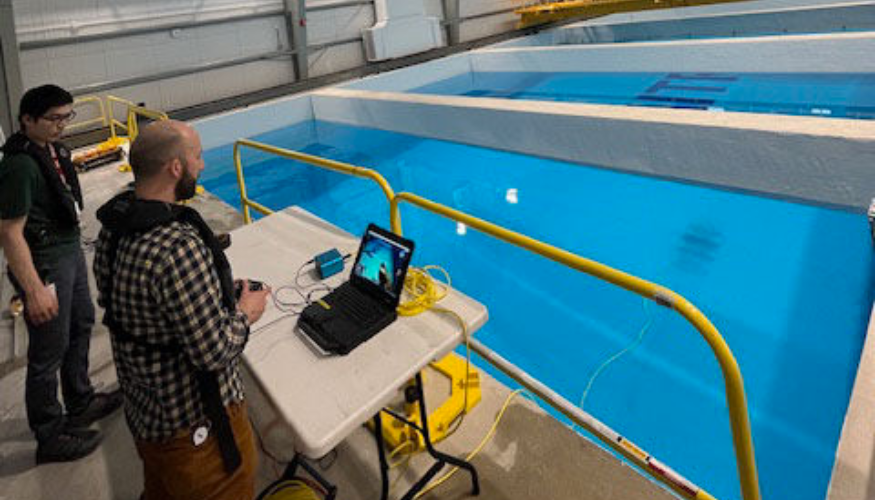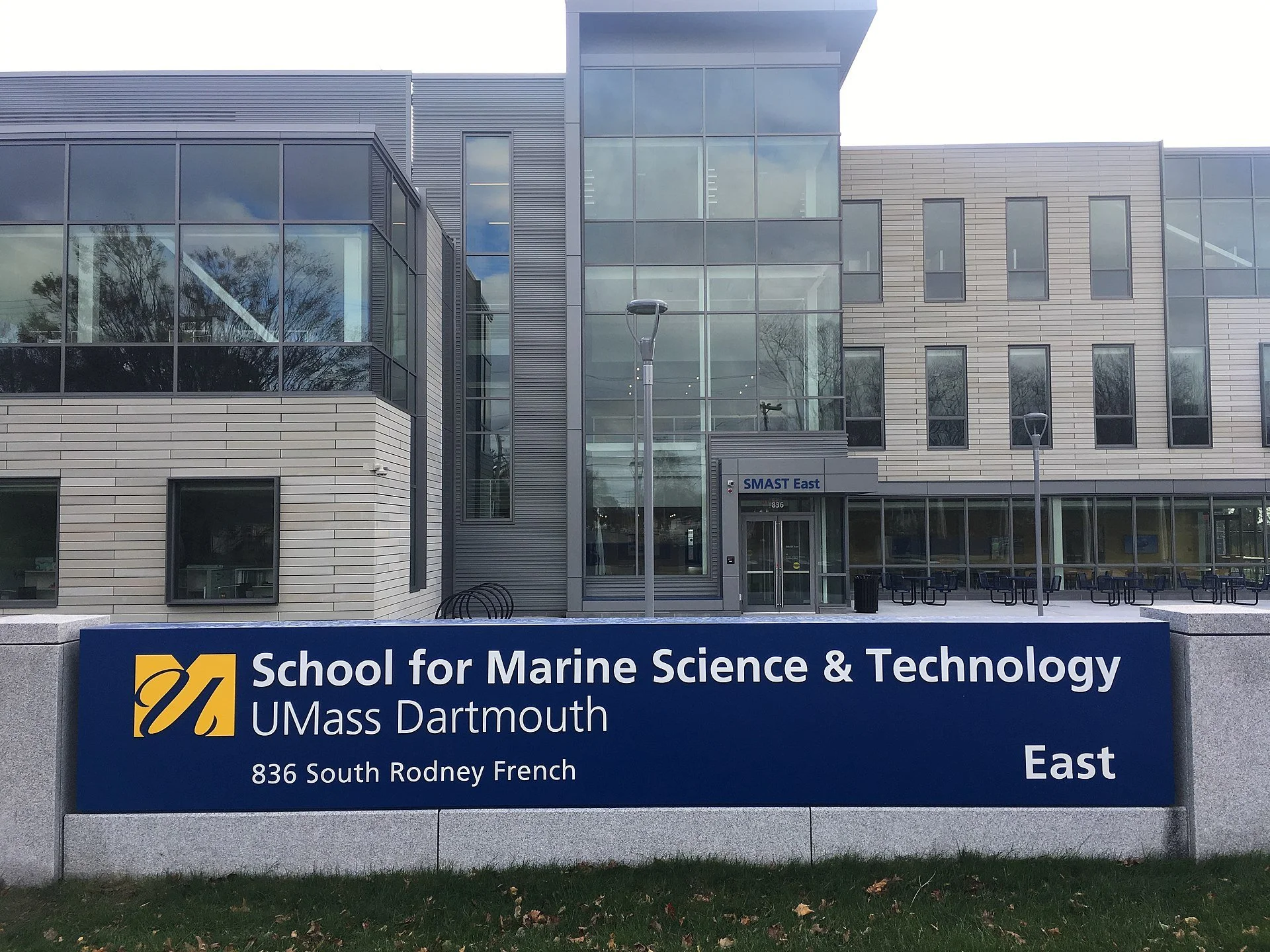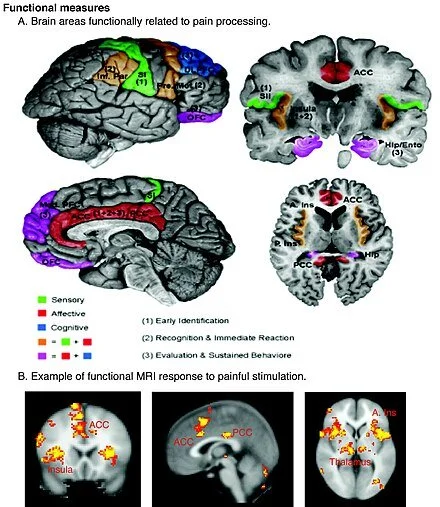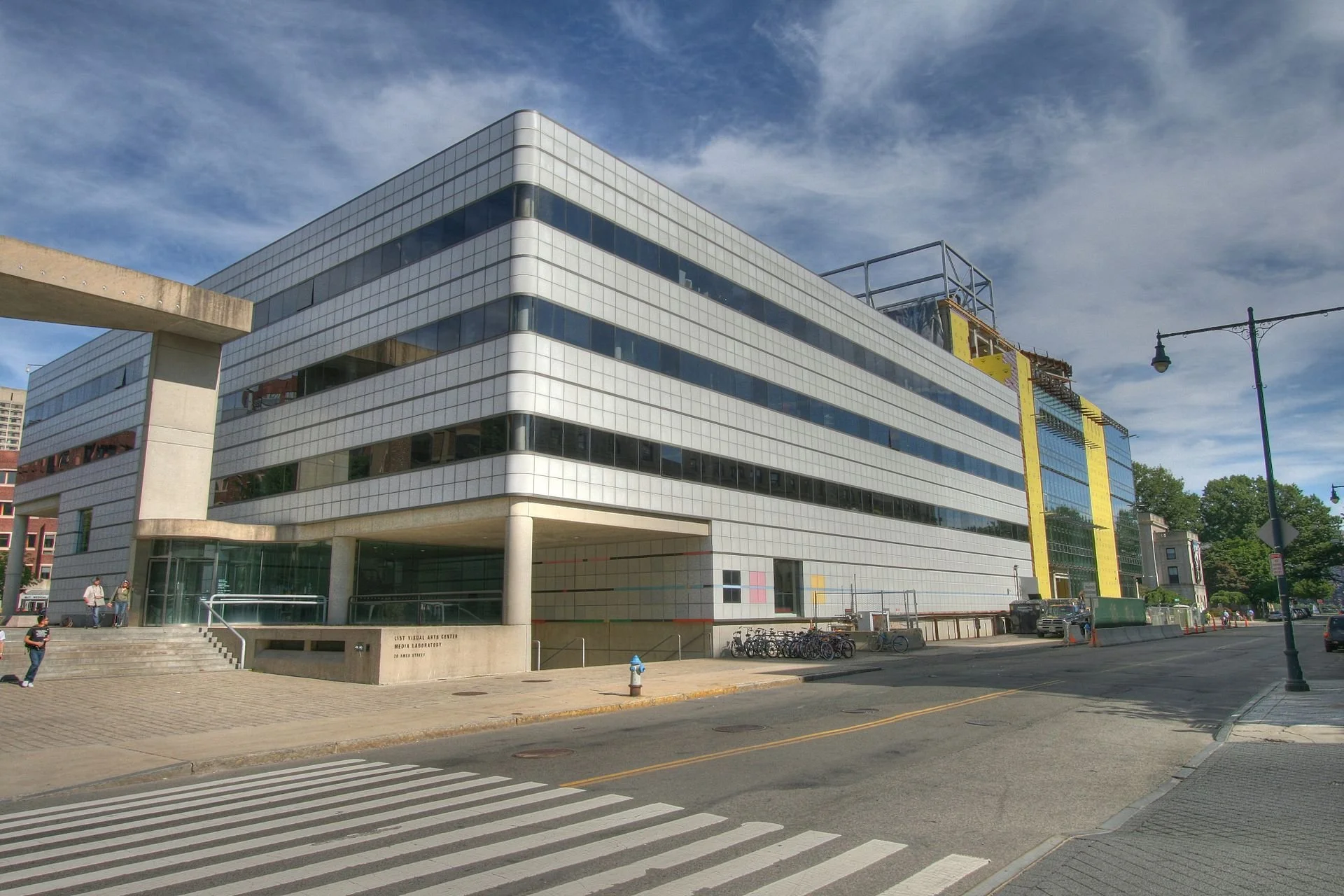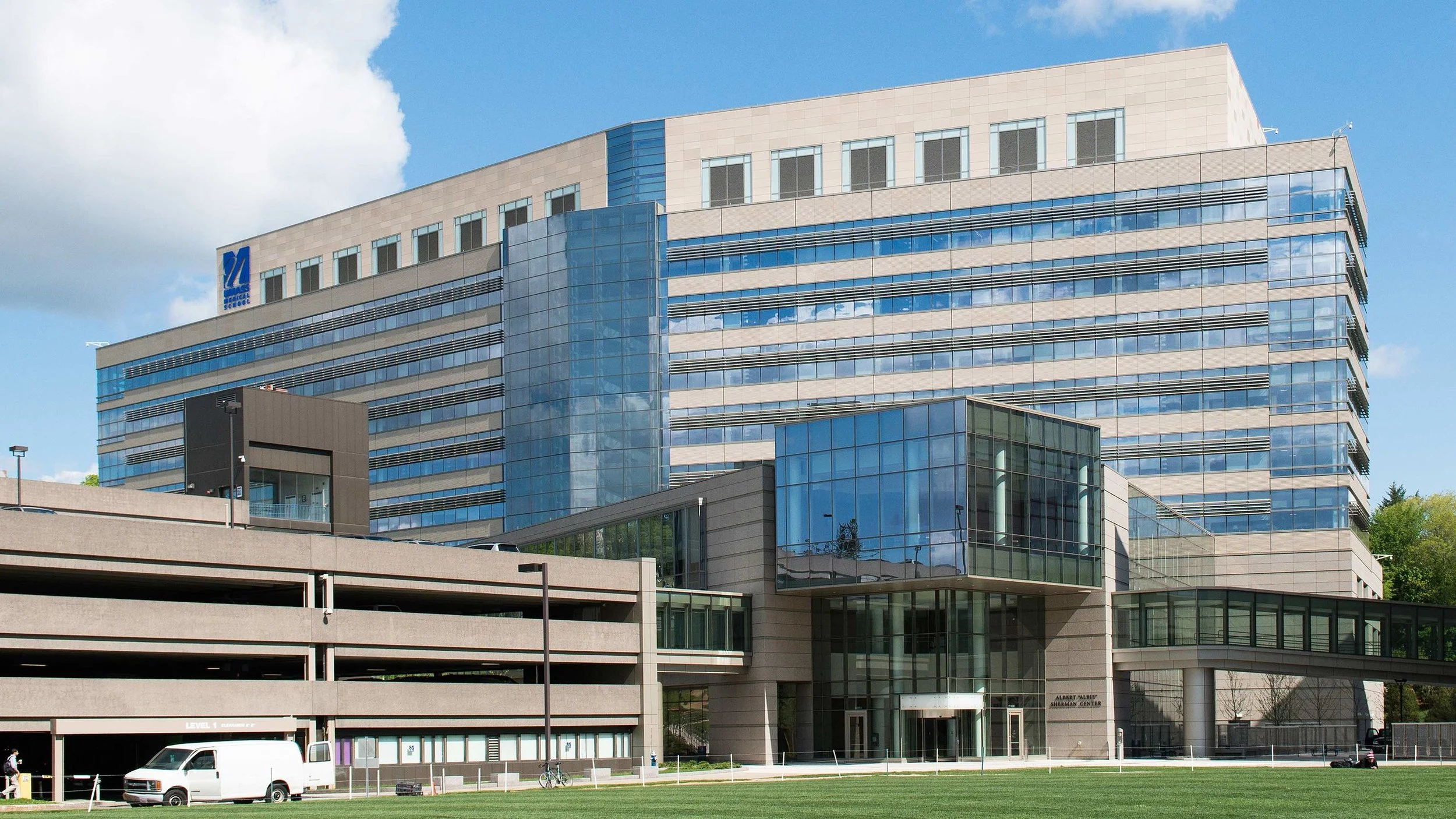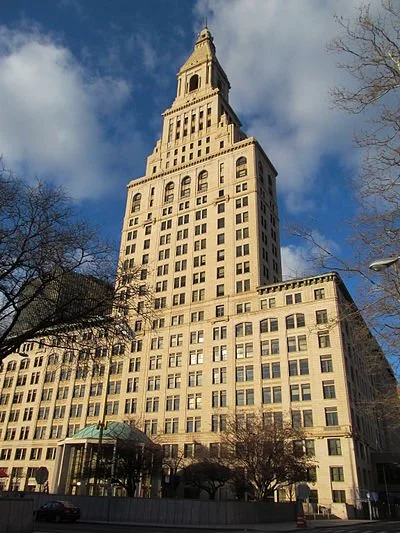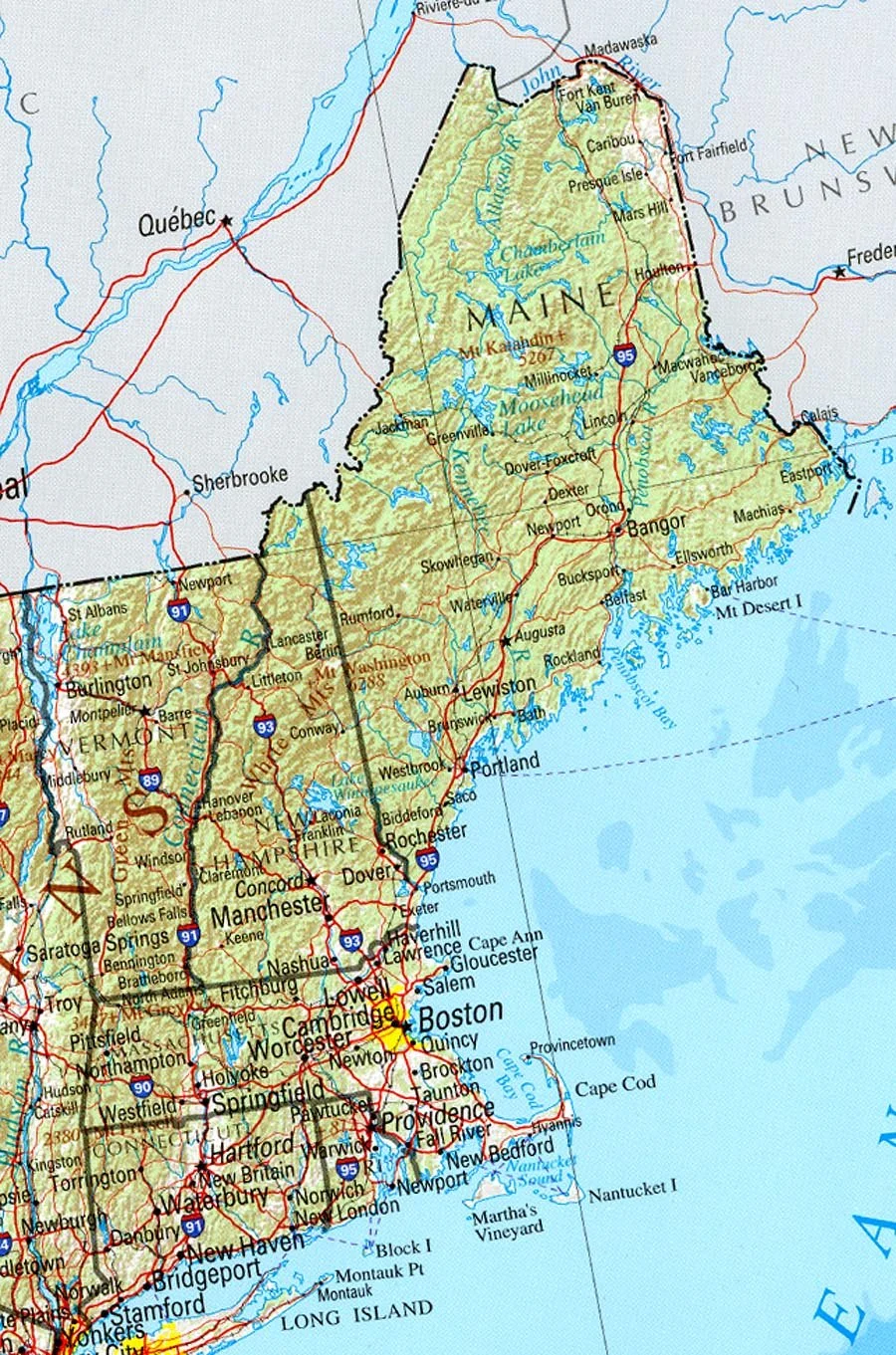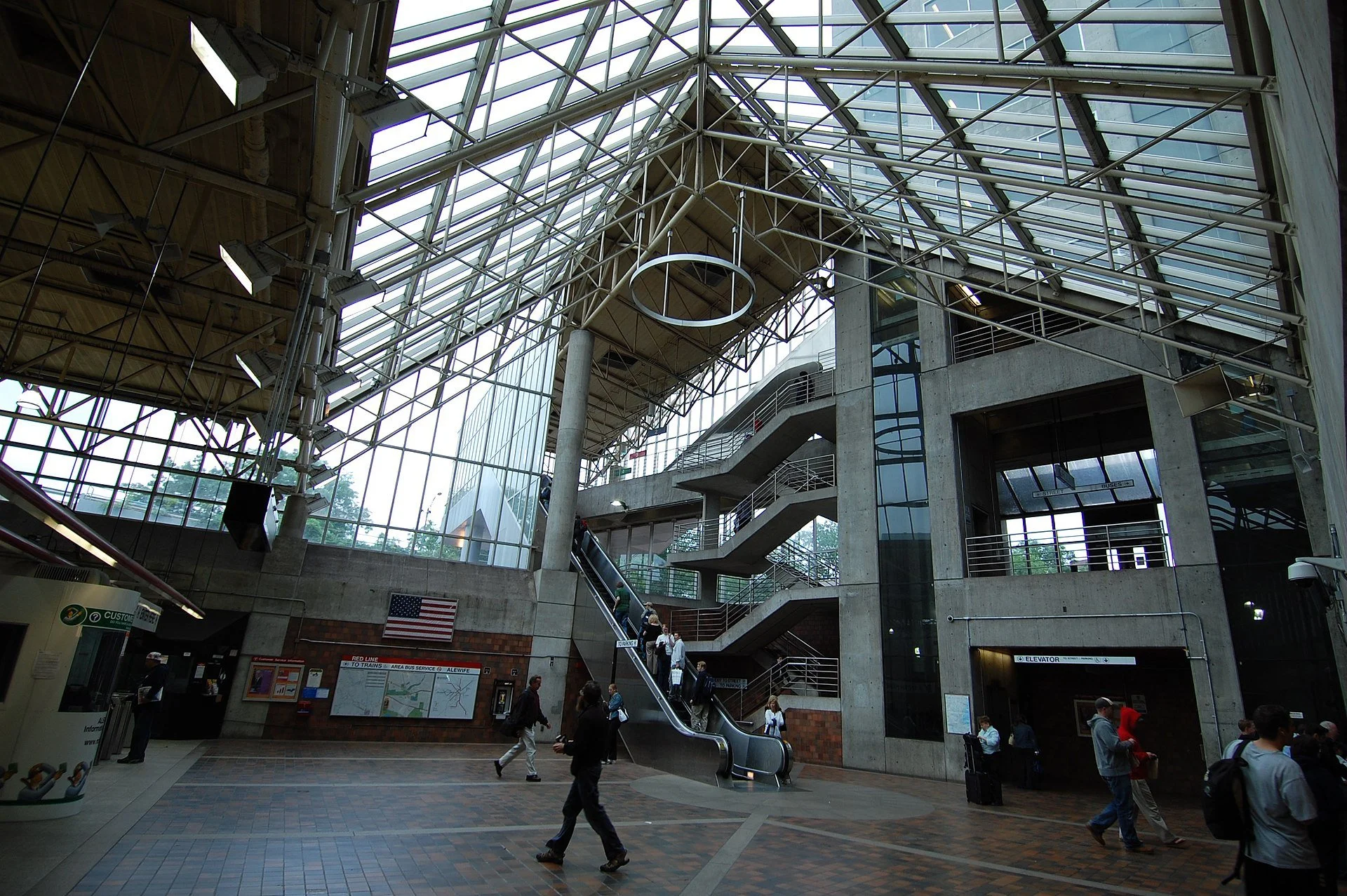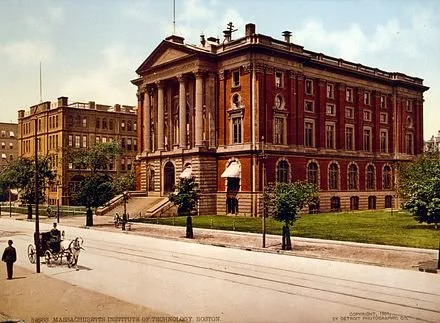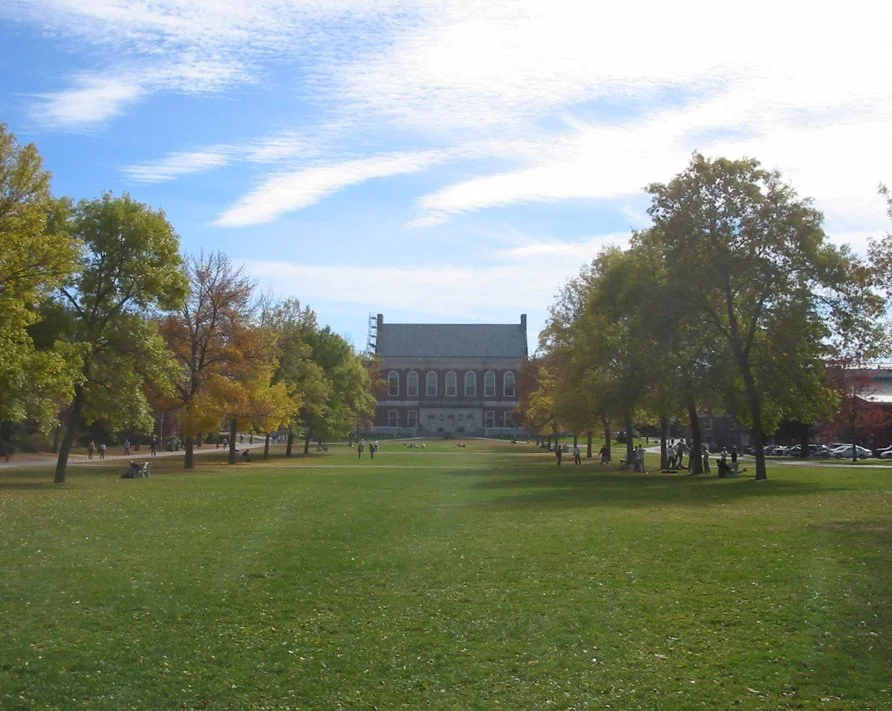
Getting into AI ‘black boxes’
Edited from a New England Council report
“Northeastern University, in Boston, has been granted $9 million to study how advanced artificial intelligence systems operate and their societal impacts. The grant, announced by the National Science Foundation (NSF), will let Northeastern to create a collaborative research platform.
“This platform aims to let researchers across the U.S. examine the internal computation systems of advanced AI, which are currently opaque because of their ‘black box’ nature.
“NSF Director Sethuraman Panchanathan said: “Chatbots have transformed society’s relationship with AI. However, the inner workings of these systems are not yet fully understood.’
“The research will focus on large language models, such as ChatGPT and Google’s Gemini. These models will be used alongside public-interest tech groups to ensure that AI advancements adhere to ethical and social standards.’’
Northeastern University's EXP research building.
Mitre’s BlueTechLab
— Mitre photo
Edited from a New England Council report
BOSTON
“The nonprofit Mitre Corp. recently announced that a team from Chelmsford, Mass.-based product-development company Triton Systems Inc. has become the first commercial enterprise to use Mitre’s new BlueTech Lab for testing. The lab is at Mitre’s Bedford, Mass., campus and was built to support the company’s expanding marine-technology work. (Mitre is headquartered in Bedford and McLean, Va.) The lab incudes a 620,000-gallon test tank (above) that can be used to study communication and acoustic sensing on uncrewed undersea and surface vehicles.
“Triton Systems used the lab’s test tank to analyze the behavior of a small vehicle they are developing for a Department of Defense client. Angelica Cardona, a Triton engineer, had told Mitre that her company was eager to use the lab because of its ample workspace and controlled atmosphere.
“‘Being here saves us so much time and money. Without this resource, we’d be dealing with the logistical burden of getting out to sea and testing in mucky waters,’ said Cardona.’’
Feds name Southeastern New England 'Ocean Tech Hub'
Central entrance at the University of Massachusetts at Dartmouth’s New Bedford campus.
— Photo by Ogandzyuk
Edited from a New England Council report
“Recently, the U.S. Economic Development Administration named Rhode Island and Southeastern New England as one of 31 Tech Hubs, calling it the ‘Ocean Tech Hub’. These Tech Hubs bring together public, private and academic partners into collaborative consortia to drive regional growth. The Ocean Tech Hub will focus on the autonomous systems industry and specialize in ocean robotics, sensors and materials in Rhode Island and Massachusetts.
“The hub also received a Tech Hubs Strategy Development Grant that will help the consortium increase local coordination and further manufacturing, commercialization and deployment efforts. About $500,000 of the grant funding is being put towards the hub’s ‘Grow Blue Initiative,’ which is working toward building the Southeastern New England economy through building a diverse and equitable industry to bolster commercial resilience, creating a diverse range of job opportunities, and utilizing internal and external partnerships.
“‘With big implications for climate adaptation and change mitigation, national security, and economic development, this opportunity impacts our startups, researchers, and workforce—and has implications for childcare, transportation, and housing needs,’ said Daniela Fairchild, the chief strategy officer at the quasi-public Rhode Island Commerce Corp.’’
Vertex touts what it says is an effective nonaddictive post-surgical painkiller (Copy)
Regions of the cerebral cortex associated with pain
Edited from a New England Council report:
“Boston-based Vertex Pharmaceuticals recently announced that its new experimental painkiller is as effective as an opioid when treating acute, post-surgical pain. Vertex claims that this new drug carries no risk of addiction, unlike with opioids.
“The painkiller, currently called VX-548, is set to be sent to the FDA for approval by mid-year. Though the drug has yet to outperform others when treating pain, that VX-548 is equally effective as some opioids without the risk of addiction could prove to be groundbreaking. Opioids have caused a decades-long endemic in the US, with almost 83,000 people in the U.S. dying from opioid overdoses in 2022 alone. Despite the highly addictive nature of these drugs, they are still commonly prescribed by doctors for post-surgical pain. If approved, VX-548 could mark a new age of pain treatment and a possible end to the opioid crisis.
“‘We are very pleased with the results from the VX-548 pivotal program, which demonstrate a compelling and consistent combination of efficacy and safety across multiple acute pain conditions and settings,’ Reshma Kewalramani, Vertex’s chief executive and president, said.’’
This book examines the history of the Sackler family, including the founding of Purdue Pharma, and the family's central role in the opioid epidemic. The book followed Keefe's 2017 article on the Sackler family in The New Yorker, titled “The Family That Built an Empire of Pain.’’
MassArt’s Common Good Awards
Poster for MassArt’s 2024 Auction Call for Art
Edited from a New England Council report
BOSTON
“The Massachusetts College of Art and Design (MassArt), in Boston, has announced the launch of the inaugural Common Good Awards, in celebration of its 150th anniversary as a higher-education institution.
“The awards will honor five to six exceptional individuals whose work has furthered the arts within the public sector, especially within the New England region. These efforts could come in all shapes and sizes, from an architect creating beautiful public spaces, to a civil servant whose advocacy leads to the creation of important arts programs and experiences.
“In addition to the handful of open nomination awards, there are also two specialized honors that MassArt will hand out. The first will go to a MassArt Alumnus, whose education propelled them to effectively deliver arts to the public. Additionally, the Frances Euphemia Thompson Award for Excellence in Teaching will go to a current or retired Massachusetts public school art teacher from grades K-12, whose commitment in the classroom has instilled the value of the arts into the community. The final awards ceremony is scheduled for Dec. 16.
“As the only independent, publicly funded arts and design college in the US, MassArt understands its importance as an intersection space for art and public function. ‘Arts, culture, and design are everywhere, embedded in all facets of our lives. As a public institution, we exist at the nexus of service, civic life, arts, and culture,’ said President Mary Grant.’’
Read more from MassArt.
AI institute to be set up at UMass Boston
Neural net completion for "artificial intelligence", as done by DALL-E mini hosted on HuggingFace, 4 June 2022 (code under Apache 2.0 license). Upscaled with Real-ESRGAN "Anime" upscaling version (under [https://github.com/xinntao/Real-ESRGAN/blob/master/LICENSE
At UMass Boston, University Hall, the Campus Center and Wheatley Hall
— Photo by Sintakso
Edited from a New England Council report.
The University of Massachusetts at Boston has announced that Paul English has donated $5 million to the university, with the intention of creating an Artificial Intelligence Institute. The Paul English Applied Artificial Intelligence Institute will give students on campus from all fields of study the tools that they’ll need for working in a world where AI is expected to rapidly play a bigger role. UMass said that the institute will “include faculty from across various departments and incorporate AI into a broad range of curricula,” including social, ethical and other challenges that are a byproduct of AI technology. The institute will open in the 2023-2024 school year.
Paul English is an American tech entrepreneur, computer scientist and philanthropist. He is the founder of Boston Venture Studio.
“‘We are at the dawn of a new era,’ said UMass Boston Chancellor Marcelo Suárez-Orozco. ‘Like the agricultural revolution, the development of the steam engine, the invention of the computer and the introduction of the smartphone, the birth of artificial intelligence is fundamentally changing how we live and work.’
#Artificial Intelligence #Paul English #University of Massachusetts
James T. Brett: Fixing federal tax code for technology is crucial for protecting New England’s prosperity
The Media Lab at the Massachusetts Institute of Technology, in Cambridge, houses researchers developing novel uses of computer technology. Greater Boston has long been one of the world’s greatest technology centers, primarily because spinoffs from its universities.
— Photo by Madcoverboy
BOSTON
Here in New England, we are proud of our region’s reputation as a global innovation hub. Our region hosts some of the world’s most innovative companies, in industries ranging from defense to life sciences to clean energy to technology. Each day, these businesses are making investments in ground-breaking research and development aimed at saving lives, combating climate change, safeguarding our national security and more.
For many years, the U.S. tax code has encouraged such investments by allowing businesses to fully deduct qualified research and development (R&D) expenses each year. However, under a provision of the Tax Cuts and Jobs Act of 2017, which was signed into law by then-President Trump, businesses must amortize or deduct these expenses over a period of five years. This provision went into effect for the 2022 tax year.
This will ultimately make R&D more costly to conduct in New England and across the U.S. The New England Council believes firmly that the new R&D amortization requirement will halt and harm our region’s continued growth and leadership on the global stage.
As a result of this change, the U.S. is now only one of two developed countries requiring the amortization of R&D expenses. Comparatively, our nation’s competitors, such as China, currently provide a “super deduction” for R&D expenses that drastically increases the allowed amount deducted for companies that previously did not qualify.
This change could result in companies relocating R&D facilities and funding out of the country, because it will be more costly to do research in the U.S. This will not only damage our competitiveness, but it could also have significant national security ramifications, as well as job losses.
In fact, a recent study conducted by EY for the R&D Coalition found: “Failing to reverse this change will cost well-paying jobs and reduce future innovation-directed R&D. Requiring the amortization of research expenses will reduce R&D spending and lead to a loss of more than 20,000 R&D jobs in the first five years with the number of lost jobs rising to nearly 60,000 over the following five years. Moreover, when accounting for the spillover effect from R&D spending, nearly three times as many jobs will be affected. This same study also found that for every $1 billion in R&D spending, 17,000 jobs are supported in the U.S.”
Fortunately, two members of Congress from New England are among those leading the bipartisan charge to reverse this harmful change in the tax code.
In the U.S. Senate, Sen. Maggie Hassan ( D.-N.H.) has partnered with Sen. Todd Young (R.-Ind.) to introduce the American Innovation and Jobs Act. In addition to allowing companies to fully deduct R&D expenses each year, Senator Hassan’s bill would also raise the cap over time for the refundable R&D tax credit for small businesses and startups, and expand eligibility for the refundable R&D tax credit so that more startups and new businesses can use it.
In the U.S. House, Congressman John Larson (D.-Conn.) has teamed up with Rep. Ron Estes (R.-Kan.) to introduce similar legislation, known as the American Innovation and R&D Competitiveness Act. Similar to the Senate bill, Representative Larson’s proposal would allow companies to continue to fully deduct R&D expenses each year.
The New England Council is proud to support both of these bills, and we urge others in the business community to also encourage Congress to pass this legislation. We have written to members of the New England congressional delegation, calling on them to support these bills, and are hopeful that Congress will take action to pass them in the near future.
Doing so will help ensure that the U.S. remains globally competitive, and it will drive continued innovation and job creation right here in New England, ensuring that the region remains a global innovation hub.
James T. Brett is president and CEO of The New England Council (newenglandcouncil.com)
Big construction projects at Mass. colleges
Albert Sherman Center at the University of Massachusetts Chan Medical School, in Worcester.
— Photo by Kjfoster93
Edited from a New England Council (newenglandcouncil.com) report
BOSTON
A variety of Massachusetts colleges and universities are undergoing major renovation projects. These include Bunker Hill Community College, Massachusetts Institute of Technology, University of Massachusetts Chan Medical School and Endicott College.
This spring, MIT will be putting up projects to add more on-campus housing and additional buildings for interdisciplinary programs, including music and other arts. UMass Chan Medical School, in Worcester, will be investing $325 million in a building that will significantly increase the capacity for education and research, including clinical-trial therapeutics and animal medicine. Endicott College, in Beverly, received a $20 million donation from the Cummings Foundation for a new Cummings School of Nursing and Health Sciences building. Bunker Hill Community College will be constructing its first new building in a decade, set to open in 2025.
Using drones to monitor changing Eastern forests
Mt. Katahdin, in the midst of the Maine Woods.
Log jam at Ripogenus Gorge, Maine, during 1870s log driving.
Edited from a New England Council report (newenglandcouncil.com)
“The U.S. Department of Agriculture has awarded a $10 million grant to research teams from the University of Maine, Purdue University and the University of Georgia to develop technology that would use drones to monitor forests.
“The main goal of this research project is to help landowners and stakeholders better adapt forests to complicated economic and climate conditions in the Eastern region of the United States, aiming to improve the management of 15 million acres of those forests. With this, the University of Maine will be receiving $2.7 million of the overall $10 million for its efforts on ‘PERSEUS,’ or ‘promoting economic resilience and sustainability of the eastern United States forests.’ This project will use digital technology including drones, piloted aircraft, and satellite-based sensors which will provide real-time, accurate measurements of the forests. The information collected from this project will be extremely influential to forest policy and the lawmaking of the region.
“‘Forestry generally prides itself as a boots-on-the-ground business, while technology is rapidly changing access to information, [but] PERSEUS will provide the necessary training to help both students and landowners alike leverage these new tools,’ said Aaron Weiskittel, professor of forest biometrics and modeling, and director of the Center for Research on Sustainable Forests, at the University of Maine.’’
NHL promoting street hockey
A street hockey game.
Edited from a New England Council report:
“The National Hockey League has announced a partnership with RCX Sports, a leader in youth-organized sports, to create ‘NHL Street,’ a North American wide, youth street hockey league.
“Although the NHL was involved in street hockey programs in the 1990s, this rebirth has rebranded with a new look and its mission, NHL Street is a program with the intent to build a new era in street hockey that is fun, relevant and aimed at getting more kids involved in playing the game. This program also breaks down financial barriers that have prevented children from playing in the past by advocating for an accessible form of the game….
“‘We want to create good memories,’ said Andrew Ference, National Hockey League director of social impact, growth and fan development. ‘We don’t need to create a whole batch of the next NHLers. That might happen organically on its own, but we just want [to] create really fun times and memories with hockey.’’’
Aiming to decarbonize Boston’s Fenway neighborhood
Fenway–Kenmore neighborhood seen from Prudential Skywalk in 2012, with Fenway Park the dominant feature.
—Photo by Melikamp
Edited from a New England Council report (newenglandcouncil.com)
Boston-based Vicinity Energy has announced a partnership with IQHQ Inc., a life-sciences real estate development company, in which Vicinity’s carbon-free, renewable thermal energy will be used in IQHQ’s developments in Boston’s Fenway neighborhood.
Vicinity Energy has been active in efforts to decarbonize communities, from buildings to college campuses to entire neighborhoods. Now, with this partnership, the company is bringing this technology to Fenway. The first stop will be IQHQ’s development at 109 Brookline Ave., set to be Boston’s first entirely carbon-neutral building. To achieve these goals, Vicinity has been developing a technology referred to as ‘eSteam,’ an energy that uses decarbonized operators and does not require on-site boilers or chillers. Vicinity officials plan to start delivering eSteam in 2024.
“This eSteam partnership not only signifies our commitment to a clean energy future, but it also demonstrates the commitment from progressive, innovative industry leaders, like IQHQ, who are committed to lower carbon emissions and to combat climate change,” said Bill DiCroce, president and chief executive of Vicinity Energy.
James T. Brett: Omnibus federal bill advances some key New England programs
Manchester, N.H., with its old textile mills along the Merrimack River converted to other uses, such as technology and health care.
BOSTON
In the final days of the 117th Congress, just a few weeks ago, Congress passed a $1.7 trillion Omnibus Appropriations Bill for fiscal 2023, and President Biden signed it into law on Dec. 29. Included in this sweeping legislation are landmark investments in education, health care protecting our environment, supporting working families and investing in research and innovation. The New England Council – the nation’s oldest regional business association – was pleased to see many of our longtime priorities included, and we believe that this legislation will help drive our region’s continued economic growth.
Here are a few of the biggest wins for New England in the bill:
Increased Pell Grant – The Pell Grant is a key tool to expanding access to higher education, providing support for low-income students to attend college. The council has long supported increasing the maximum Pell Grant amount – in fact, we have advocated doubling the maximum grant. While the omnibus did not go so far as to double Pell, it did increase the maximum award by $500, to $7,395, for the 2023-2024 school year, marking the largest increase since the 2009-2010 school year. This boost is a step in the right direction toward making college more affordable for millions of students and preparing the workforce of the future.
Federal Research Funding – New England is home to some of the top research institutions, including world-class universities and hospitals. These facilities conduct research on some of the most pressing medical and scientific challenges facing our nation. As such, the council has long supported federal investments in research, and so we were pleased that the bill included $47.5 billion for the National Institutes of Health (NIH)—a 5.6 percent increase—as well as an historic 12 percent increase for the National Science Foundation (NSF), to $9.9 billion. These investments will undoubtedly spur medical and scientific breakthroughs in our region, while supporting thousands of jobs at our research facilities.
Mental Health & Substance Abuse – The need for increased mental-health and substance-abuse services is one of the biggest health challenges facing our region, and the nation at large. The demand for services has only surged in recent years as the pandemic has presented new challenges for those who struggle with mental health and addiction. Fortunately, the spending bill included billions of dollars for new and increased services, including $1.01 billion for Mental Health Block Grants, $385 million for Certified Community Behavioral Health Clinics, and $1.6 billion to states to address the opioid-misuse epidemic through the State Opioid Response Grant. These funds will help expand much-needed services in our communities and set millions of people on the path toward recovery.
Energy Efficiency & Renewable Energy – The New England region is a leader in efforts to decrease carbon emissions and develop renewable-energy resources. The spending bill included a number of measures that will support this effort and help create new jobs in the clean-energy sector. The $3.46 billion appropriated in the bill for Energy Efficiency and Renewable Energy—a $260 million increase over the previous fiscal year—will allow for investments in vehicle technologies, hydrogen research and development, weatherization-assistance programs and renewable-grid integration, as well as marine, wind, and solar energy.
Retirement Savings – Finally, the spending bill also includes a number of provisions aimed at bolstering retirement savings and ensuring a secure financial future for millions of American workers. The bill included a legislative package championed by the dean of the New England House delegation, U.S. Rep. Richard Neal (D.-Mass.), known as SECURE 2.0. Specifically, the bill will expand access to retirement- savings-plan enrollment, allow emergency withdrawal from plans, increase the opportunity to make catch-up contributions, and support workers paying off student-loan debt, just to name a few. Inclusion of these provisions will undoubtedly help U.S. workers better prepare for their futures.
Beyond these provisions, the spending bill also includes investments to bolster working families, expand access to affordable housing, and support our law enforcement, military and veterans. The New England Council is grateful to our region’s congressional delegation for its members’ efforts to advocate for our region’s priorities in this important piece of legislation. We have no doubt that our region’s economy will benefit from the important investments this bill makes in the year ahead.
James T. Brett is the president & CEO of The New England Council, a Boston-based regional alliance of businesses, non-profit organizations,including and health and educational institution,s dedicated to supporting economic growth and the quality of life in New England.
Flag of the New England Governors Conference.
Insurer’s app for injured employees
The 24-story Travelers Tower, in Hartford, built in 1919. The tower remains the largest office of the big insurance company, although Travelers’ headquarters is now in New York City. Hartford was once called “The Insurance Capital of the World.’’
Edited from a New England Council report (newenglandcouncil.com)
“Travelers Cos. Inc has launched an app to help promote mental health and facilitate recovery for injured employees. By using technology from Wysa called ‘The Wysa for Return to Work’ app, which is programmed by artificial intelligence, Travelers has found a way to help employees improve their mental resilience.
“Travelers found that around 40 perceny of injured employees experienced a psychosocial barrier that stagnated their recovery. Nurses at Travelers define psychosocial barriers as an attitude, state or consciousness that affects a person’s ability to communicate.
‘‘‘The Wysa for Return to Work’ app responds to users through a secure texting-style platform to offer assistance such as cognitive behavioral techniques and breathing exercises to alleviate mental health struggles. The results from the initial launch of the app have been promising. Travelers report that workers using the app missed one-third fewer workdays versus employees not using the app.
“Dr. Marcos Iglesias, chief medical director at Travelers, said, ‘Factors unrelated to an individual’s injury, such as fear, unrealistic expectations, lack of sleep or minimal social support, can hinder the recovery process. Helping injured employees bounce back requires an approach that addresses an individual’s physical and mental health challenges.”’
N.E. Council pushes for region to host new health-research agency
Cell culture vials
BOSTON
The New England Council (newenglandcouncil.com), the leading regional lobbying organization, has been touting Massachusetts to be the home of the new Advanced Research Projects Agency for Health (ARPA-H). And now council President James Brett is also imploring federal officials them to take a wider view and “consider the unparalleled resources” of the entire New England region.
“New England is known as one of the world’s premier life sciences hubs, and is home to many of the world’s top medical, education, and research facilities. In fact, New England centers of higher education and research institutes received over $4.5 billion in [National Institutes of Health] funding in 2021. Additionally, the region supports over 56,000 jobs directly tied to NIH funding, and supports just over $10 billion in economic activity.’’
Mr. Brett added, “In addition, the New England region boasts a dynamic workforce and innovation ecosystem. New England is home to a highly skilled talent pool to supply the quality and quantity of employees that ARPA-H will need.”
This came in a letter Mr. Brett wrote to U.S. Secretary of Health and Human Services Xavier Becerra, ARPA-H Director Dr. Renee Wegrzyn and a top White House science adviser.
New Englander of the Year awards
The New England flag.
Hit this link to see The New England Council’s 2022 celebration, including recipients of its “New Englander of the Year” award.
NHL wants to speed efforts to expand diversity
The Boston Bruins at work against the New Jersey Devils.
Edited from a New England Council (newenglandcouncil.com) report
“The National Hockey League has released its Diversity and Inclusion Report, which presents the NHL’s efforts to accelerate diversity and inclusion in the sport of hockey. This is an ongoing effort by the league to prioritize inclusion and to grow a stronger hockey community.
“By focusing on seven dimensions, including goals such as leadership, community engagement, partnerships and more, the NHL organized the report to present quantitative and qualitative progress the league has made over the last two years. The report found that 22 teams launched or are in the process of launching mentorship programs to develop BIPOC and female talent to create a pipeline of opportunities for candidates in front office and operation positions. BIPOC”: stands for Black, Indigenous, People of Color.
“The NHL emphasized its need to increase the exposure of the sport to women and BIPOC communities–in partnership with the NHL Player’s Association Industry Growth Fund, the NHL has distributed more than $135 million in funds in the US and Canada to fund programs to reach these audiences. Stepping outside the rink, the report noted a committed effort by the League to support community engagement both in the sport and local communities. To reach this goal the NHL has advocated for various legislation promoting social equality, including the Willie O’Ree Congressional Gold Medal Act to honor O’Ree’s contributions to the sport as the first NHL Black player. The report highlighted the accomplishments of the League but also acknowledged that there is still room for improvement. The NHL expressed its need to address issues of prejudice and discrimination by using the tools of education and accountability. To continue the conversation about social justice all 32 teams will participate in a program to which will address issues such as discrimination, harassment, and abuse. The NHL hotline was released to give both players and employees a way to report unethical conduct.
“Commissioner Gary Bettman said, ‘Our belief is stronger than ever that hockey has a powerful platform to build character, teach life skills, and support our society and our communities. We’re focused on ensuring the game and its related environments are safe, respectful, and inclusive. Diverse representation within inclusive environments is proven to advance innovation, creativity, and decision-making – all of which are critically important to the growth of the sport and our business.”’
An economic-mobility hub
The spectacular fare lobby of the Alewife MBTA station. The station is also known for its art works, inside and out. See photo at bottom.
— Photo by Eric Kilby
Edited from a New England Council report (newenglandcouncil.com)
“Rockland Trust Bank, based in Rockland, Mass., has announced a grant of $50,000 to Just A Start. The grant will be used to help support Just A Start, a new economic-mobility hub near the Alewife MBTA station, in North Cambridge.
“The new Economic Mobility Hub will be a 70,000-square-foot, mixed-use project. The goal of the project is to create a thriving and equitable community to accelerate economic mobility. Once completed the building will include 24 affordable apartments, four pre-school classrooms and a 19,000-square-foot training center. This new home for Just A Start will offer workshops and other programming to serve 2,800 people in Cambridge and Metro-North communities. The project will be open in April 2024.
“Andrea Borowiecki, Vice President of Charitable Giving and Community Engagement at Rockland Trust, said, ‘Our Charitable Foundation is honored to contribute to the development of this important project for the Greater Boston communities. The project perfectly aligns with what Rockland Trust as a community-orientated bank believes in, by providing resources to our neighbors that enable them to flourish to their full potential.”’
“Alewife Cows,’’ by Joel Janowitz
Sculpture outside the Alewife station by Toshihiro Katayama
Photo by Pi.1415926535
New MIT device can help Parkinson’s patients
Views of a man portrayed to be suffering from Parkinson's disease. These are woodcut reproductions of two collotypes from Paul de Saint-Leger's 1879 doctoral thesis, “Paralysie agitante..etc.”
From The New England Council (newenglandcouncil.com)
“New England Council member the Massachusetts Institute of Technology has created a device that can assist patients with Parkinson’s disease. The system can work as a proactive way to gauge if someone has Parkinson’s disease as well as monitor patients by tracking how they walk.
“The device uses a radar-like technology with a radio transmitter-receiver installed in a person’s home as a non-invasive treatment option. To test the effectiveness of the device, MIT researchers observed a group of 50 people, 34 of which were diagnosed with Parkinson’s disease. They found that the receiver collected a grand total of 200,000 observations. From these data, researchers found that they were able to measure the effectiveness of Levodopa, a medication given to patients to manage their symptoms.
This system would minimize Parkinson’s patients’ need to schedule extra appointments as physicians could monitor their patients remotely and review the observation points in order to prescribe the best dosage for medications.
“Dina Katabi, lead professor on the project said, ‘We know very little about the brain and its diseases. My goal is to develop non-invasive tools that provide new insights about the functioning of the brain and its diseases.”’
MIT’s Rogers Building in Boston’s Back Bay in 1901. The school moved to its Cambridge campus in 1916.
Future of higher education in New England prisons
Aerial view of Massachusetts Correctional Institute (MCI) at Concord.
— Photo by Nick Allen
From the New England Council (newenglandcouncil.com)
“Earlier this year, the New England Board of Higher Education (NEBHE), and The Educational Justice Institute (TEJI) at MIT launched the New England Commission on the Future of Higher Education Behind Bars. New England Council President & CEO Jim Brett has been asked to serve on this commission. Both NEBHE and MIT are New England Council members.
Research shows that there are 201,860 people who are currently incarcerated, on parole or on probation in New England. Additionally, 58 percent of all formerly incarcerated people in the New England region do not have a high-school diploma or equivalent whereas only 13 percent of non-incarcerated New Englanders have not achieved a high school diploma or equivalent. Further, incarcerated people who participate in higher education behind bars are 48 percent less likely to recidivate than those who do not.
This commission plans to formally convene about 65 individuals who represent key stakeholder groups relevant to prison education, including: key corrections and postsecondary leaders, previously incarcerated individuals, employers, policymakers and governors. In addition, it will issue a formal report that includes stakeholder-specific recommendations and a detailed action plan to make New England a leader in higher education behind bars ahead of the Pell release in 2023.
Additional information can be found here and here.
For more information on this issue please contact Sheridan Miller at smiller@nebhe.org. For information on the New England Council’s Higher Education Committee please contact Mariah Healy, director of Federal Affairs, at mhealy@newenglandcouncil.com.”
In Maine, working on virtual reality and self-driving cars
Researcher with a virtual reality headset.
— Photo by ESA, CC BY-SA IGO 3.0
Edited from a New England Council (newenglandcouncil.com) report
“Researchers at the University of Maine’s Virtual Environment and Multimodal Interaction Lab (VEMI) are working on cutting-edge technology to contribute to the development of self-driving cars and virtual reality. The VEMI lab recently won a grant from the U.S. Department of Transportation’s Inclusive Design Challenge for $300,000 to fund research for autonomous vehicles.
“The VEMI lab was founded by Dr. Rick Corey and Dr. Nick Giudice in 2008 with the idea of creating a space that students and faculty from different disciplines can come together to create technology-based solutions to global problems. With this new federal funding, VEMI lab scientists will create a ride-hailing app targeted at helping older adults and the visually impaired. The app would use electric cars that would be maintained at a central hub and use a payment system based on membership rather than a per ride. The autonomous vehicles would help older adults and people who are visually impaired access safe rides in such areas as rural Maine where access to public transportation or ride shares can be hard to find.
“Dr. Corey said, ‘[W]e don’t want to be constrained to the classroom or the traditional lab. We’re in the business of trying to make the world a slightly better place, and to break down the barriers between technology and people.’’’
At the University of Maine’s flagship campus, in Orono, on Marsh Island
— Photo by Jalnet2




